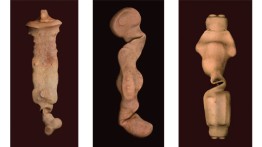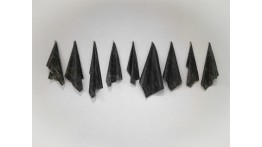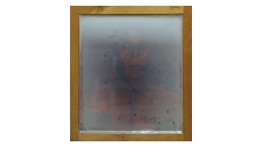“Baneful Medicine” Exhibition Questions the Ethics of Medical Research
POSTED ON: April 13, 2018
This spring, Faculty of Humanities and Social Sciences professor Andrew Weinstein presents “Baneful Medicine,” an exhibition of contemporary artists’ work that responds to medical experiments past and present. While much of the work on view refers to the experiments performed by Nazi doctors and researchers, Professor Weinstein has also chosen art that considers today’s bioethical quandaries. As he puts it in the exhibition catalog, “How will biotechnological developments affect society’s laws and norms? How much more conscientious are medical scientists today than they used to be?”
The show grew out of a conference Professor Weinstein attended in 2015 sponsored by the research group, Center for Medicine after the Holocaust (CMATH). The group, which was founded in 2010 by Cooper alumnus Sheldon Rubenfeld, a clinical professor of medicine at Baylor University in Texas, proposes that medical professionals today study the grotesque ethical breaches of doctors and nurses during the Holocaust to provoke thought about their own practices. As they put it on their web site, “CMATH is concerned that healthcare personnel, like all human beings, have the capacity to believe they are doing good when they are actually doing harm.”
Their worries about the ethical limitations of today’s researchers—including those working in democratic nations—is hardly unfounded: as the catalog of “Baneful Medicine” reminds viewers, the medical experimentation under the Nazi regime had its roots in American eugenics, borrowing both its ideas and terminology. Susan Erony’s “Tower of Babel: 1 September 1939” (2016) shows a letter signed by Adolf Hitler authorizing the murder of —asylum patients—men, women, and children—deemed defective by the Third Reich set against an opaque drawing of a ziggurat. The tower refers to the Nietzchean notion of the Übermensch, or superman, who is at the top of the social hierarchy because of his qualities as a leader, though for the philosopher it did not have a racial implication. The Nazis then created a category of Untermenschen or sub-humans, borrowing the concept of “under-men” created by Lothrop Stoddard, an American eugenicist and Klansman, to act as a foil to the Aryan superman.
The infamous Tuskegee syphilis experiment, which ran from 1932 to 1972, predated the Nazi medical testing. The U.S. Public Health Service claimed to offer free health care to impoverished black men in Alabama, but they failed to tell those infected with syphilis that they had the disease so researchers could study its effects. The horror of such experimentation was acknowledged by President Bill Clinton in 1997. For “A National Problem” (2018), Todd Ayoung reprints Clinton’s words and adds to them, contextualizing Tuskegee as part of multiple racist affronts experienced by African Americans, including police violence and discriminatory housing policy. The letter calls for “a national discussion about reparations.” Notably Ayoung includes a presidential seal but the letter is signed “The President of the United States”—to date no actual president has connected these events.
Another art work that illustrates the role of texts in shaping the ethics of medical research is Arie A. Galles’ “Hippocratic Oath 4” (2017). The piece shows the famed medical oath of Hippocrates written in Ancient Greek with black stripes imposed on the text, reminiscent of death camp uniforms. Nearby, Ruth Liberman’s “Closed Cases” (2016) uses letters, interviews, and other manuscripts to counter the notion that unethical medical research is something that ended with World War II and the revelation of the Nazis’ experiments. By gluing the ink from cellophane typewriter ribbon onto medical-grade latex, she reveals barely visible text that demonstrate various shocking ethical lapses. A pharmaceutical company active in China, for instance, shows support for not using the body parts of executed prisoners, but then equivocates: “Chinese legislation prevents pharmaceutical companies from determining the origins of transplant organs.”
“DNA has become a tool of surveillance, profiling and potential persecution,” Professor Weinstein writes in the exhibition catalog, a subject taken on in a video called “DNA Spoofing” (2013). Made by Heather Dewey-Hagborg, Aurelia Moser, Allison Burtch, and Adam Harvey, it wittily parodies the language and tone of scientific authority as two women demonstrate absurd ways to cover their genetic tracks. For instance, they carefully smear their lipstick together in order not to leave traces of their DNA when sipping from a paper cup. If that sounds paranoid, Larry Miller’s work “DNA Deli Cup” (2000) will make you think again: for a commission given by Creative Time, Miller made disposable coffee cups showing fingerprints and the messages “Who Owns Your Genes?” and “Copyright Your DNA.” He later retrieved some of the cups out of the garbage and put them on display as a reminder that, with the advent of DNA sequencing, we leave behind hundreds of marks of our identity every day. Miller, who started his art career as a member of the influential group FLUXUS, made art about the control of genetic information in the late 1980s when he created certificates, several on display, that attempt to give ownership of DNA to its biological owner. The project wasn’t a lark: he met with lawyers to make the certificates binding documents, but found it wasn’t possible. Although in 2013 the Supreme Court determined that natural DNA cannot be patented, by that time 20% of human genes were already owned by corporations.
Many of the works on view address genetic modification and the potential dangers of genetic testing and technology like CRISPR- Cas9, which allows scientists to modify genetic material. Aziz + Cucher used Photoshop to create images that appear to be human and mechanical parts amid formation, as if caught in utero. Verena Kaminiarz created precisely rendered death masks of lab mice that had been used in the study of muscular dystrophy for "death masks (mus musculus)” (2008). Professor Weinstein notes that Kaminiarz’s piece “is about challenging the human-centered hierarchy of bioethics today.”
Yet perhaps most moving among the exhibition’s work is a piece that exposes the decidedly human cost of grossly unethical ideas. Aharon Gluska’s “Stanislaw Drobner” (2018) shows a photograph of a man imprisoned and almost certainly killed at Auschwitz who initially Gluska could not identify. Gluska applied a gel medium over the photograph so Drobner’s features materialize slowly, revealing the defiant, contemptuous expression of a subject who refused to be victimized.
Work by the artists Vitaly Komar and Anna Halberstadt, Eduardo Kac, and Christine Borland are also on view.
On April 24, a lecture and discussion with the artists will take place in the Great Hall from 6–8:30 PM with a keynote address by Dr. Rubenfeld.
“Baneful Medicine” is on view in the library gallery until May 11.








